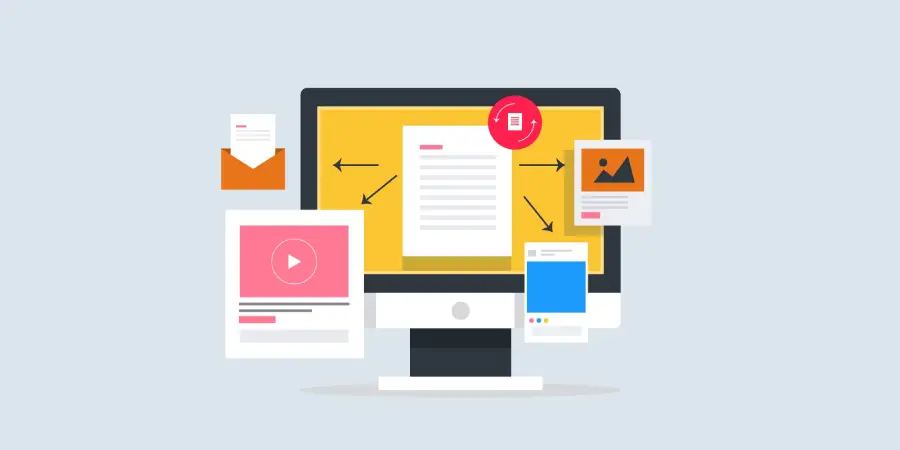When Sarah opened Instagram one morning, she saw a 15-second video of her favorite coffee brand showing the “perfect morning brew”. Later that day, she got an email newsletter from the same brand with the same idea – but this time it shared recipes of its “signature coffee blends to kickstart the day”. Intrigued, Sarah clicked on the link to the company’s website blog. Two days later, Sarah stumbled upon a podcast episode of the brand’s owner providing secret tips to make a morning “cuppa joe” like a coffee connoisseur.
Sarah didn’t feel bombarded. Instead, she felt elated. It was as if the brand understood her morning ritual and also wanted to make it a richer experience.
What Sarah experienced wasn’t coincidence. It was simply “content repurposing” – the coffee brand turned one big idea into multiple palatable formats that met customers on various digital platforms.
One Message, Told in Many Ways
As the saying goes, “The best storytellers don’t tell more stories – they tell one story in a hundred ways.”
That’s one of the key strategies that smart businesses use.
Instead of endlessly producing new narratives, they take one strong message and adapt it across formats and platforms.
Think of it as a popular movie franchise such as the Marvel Cinematic Universe. You might see it as a:
- Feature film
- A behind-the-scenes video
- A short clip
- Or even, a social media meme
Each version deepens your connection to the franchise, while keeping the story consistent.
And yes, the consistency pays off. According to McKinsey, reusing and repurposing existing marketing assets can free 10-20% of a company’s marketing budget.
That’s the power of repurposing: low waste, high reach, and stronger brand recall.
10 Steps to Repurpose Like a Pro: Step-by-Step
Let’s say your big idea is:
“80% of small businesses lose customers due to poor onboarding.”
Here’s how to turn that insight into 10 unique, high-impact pieces of content:
1. Start with the Core (Website Content Writing)
Create or connect with a content writing agency to create an in-depth blog or webpage that explains the issue, includes stats, and suggests solutions. This becomes your “hub” content – the base for all future adaptations.
2. Split it into a Blog Series
Use blog post writing services to break down the topic where each post builds SEO and authority. For instance, if you want to offer onboarding consultancy services:
- “The cost of bad onboarding”
- “3 onboarding mistakes to avoid”
- “Best tools for customer onboarding”
3. Design Social Carousels and Infographics
Pull key stats and convert them into visual snippets for LinkedIn, Instagram, or Pinterest. A social media agency can help optimize these for engagement.
4. Create Short-form Video
Transform highlights into 30-second clips or reels – perfect for quick social consumption. With strong social media services, each clip can drive traffic back to your website.
5. Host a Webinar or Live Q&A
Dive deeper into the topic with industry experts or customers. Later, this recording can feed multiple assets – from transcripts to short promotional clips.
6. Convert It into Podcast Episode
Discuss the topic conversationally for your audio audience. You can script and structure it easily using copywriting services.
7. Build an Email Newsletter Series
Create a three-part campaign highlighting problem, solution, and tools – ideal for nurturing leads through email newsletter writing.
8. Design a Slide Deck or Presentation
Summarize your insight visually for webinars, internal training, or LinkedIn SlideShare – reinforcing authority.
9. Package It into a Downloadable Guide
Combine all content into a handy PDF or toolkit. It becomes a lead magnet that drives conversions and builds your mailing list.
10. Announce it with a Press Release
Use press release writing services to share your findings or launch the toolkit. It builds credibility and reaches media audiences.
Why Repurposing Matters
- Saves Time and Money: Repurposing one idea such as turning one blog into a month of social media content can significantly cut effort and costs.
- Expands Reach Across Platforms: Your target group doesn’t live on one channel. Repurposing can help reach them via a LinkedIn post and even a YouTube video.
- Builds Consistency and Trust: Seeing the same message in varied, engaging ways reinforces brand recognition. Consistent messaging builds authority.
- Boosts SEO and Discoverability: Repurposed content ensures businesses can take advantage of keyword clusters and backlinks. This can boost rankings.
Real Brands Doing It Right
- IKEA repurposes its sustainability reports and catalogs into do-it-yourself (DIY) home setup videos, blogs and interactive augmented reality (AR) experiences.
- McDonald’s “Famous Order” idea (celebrity meal collaborations) through TV advertisements was repurposed into videos for Instagram as well as press releases and blog articles.
- Nike turned its short film “You Can’t Stop Us” into dozens of bite-sized content pieces in the form of Instagram reels, YouTube clips and inspirational blogs and podcasts.
Each brand understood one thing: every idea can live more than once – and every audience segment deserves the version that fits how they consume content.
One Big Idea, Conveyed in a Hundred Ways
Content repurposing is storytelling with intention.
Your audience, like Sarah, don’t just remember the post they saw first. They remember the story that stayed with them across platforms.
Hence, the smartest brands don’t use new resources to make more. They simply make more with what they already have. Contact us for additional information.


